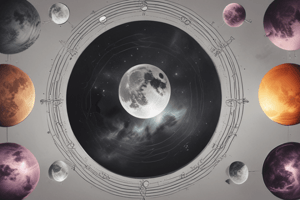Podcast
Questions and Answers
Why does the moon appear to change shape during the course of a month?
Why does the moon appear to change shape during the course of a month?
The phase of the moon you see depends on how much of the sunlit moon faces Earth. This depends on the position of the moon in its revolution.
What is a lunar eclipse?
What is a lunar eclipse?
The blocking of sunlight to the moon that occurs when Earth is directly between the sun and the full moon.
What is a solar eclipse?
What is a solar eclipse?
The blocking of sunlight to Earth that occurs when the moon is directly between the sun and Earth.
Where do you see a total eclipse and why?
Where do you see a total eclipse and why?
Where would you see a partial eclipse and why?
Where would you see a partial eclipse and why?
What is a spring tide?
What is a spring tide?
What is a neap tide?
What is a neap tide?
During what two phases of the moon does spring tide occur and why?
During what two phases of the moon does spring tide occur and why?
During what two phases does neap tides occur and why?
During what two phases does neap tides occur and why?
What causes the difference in size of high and low tides during spring and neap tide?
What causes the difference in size of high and low tides during spring and neap tide?
Why don't we have a solar and lunar eclipse every month?
Why don't we have a solar and lunar eclipse every month?
Flashcards are hidden until you start studying
Study Notes
Moon Phases
- The moon's appearance changes due to varying portions of its sunlit side facing Earth, influenced by the moon's position during its revolution.
Lunar Eclipse
- Occurs when Earth is positioned directly between the sun and a full moon, blocking sunlight from reaching the moon.
Solar Eclipse
- Happens when the moon is situated directly between the sun and Earth, obstructing sunlight from reaching Earth.
Total Eclipse Visibility
- A total eclipse can be seen from the umbra, the darkest region where the moon completely blocks sunlight.
Partial Eclipse Visibility
- A partial eclipse is visible from the penumbra, where the moon's shadow partially covers the sun, allowing part of it to remain visible.
Spring Tide
- Characterized by the largest difference between low and high tides, occurring during the new and full moon phases.
Neap Tide
- Defined by the smallest difference between low and high tides, occurring during the first and third quarter moon phases.
Spring Tide Conditions
- Spring tides take place during full and new moons when the Earth, sun, and moon align, resulting in increased gravitational pull.
Neap Tide Conditions
- Neap tides occur during the first and third quarter moons when the moon is positioned at a right angle relative to the sun, reducing gravitational pull.
Tidal Differences
- The variation in the size and extent of high and low tides during spring and neap tides is caused by differing gravitational forces of the moon on various parts of Earth.
Eclipse Frequency
- Solar and lunar eclipses do not happen every month due to the moon's orbital tilt of about 5 degrees from Earth's orbit, preventing regular alignments with Earth's shadow.
Studying That Suits You
Use AI to generate personalized quizzes and flashcards to suit your learning preferences.




